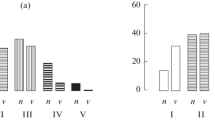Abstract
We have studied the natural regeneration of spruce (Picea abies L.) under a canopy of pine (Pinus sylvestris L.) on loamy soils. Spruce survival and growth depend on the duration of the regeneration period from the creation of the plantation and the local conditions formed as a result of uneven thinning of pine and spruce canopy. The formation of spruce population is mainly determined by trees that regenerated upon intensive thinning of 20- to 40-year-old pine trees. Spruce regeneration may be enhanced by timely cleaning cutting in pine plantations. The first one, done at the age of 15–20 years, favors pine growth and spruce regeneration. At the normal reproduction of spruce population under the canopy of 80-year-old pine plantations, the second spruce layer is formed. Trunk reserve in this layer is 20–25% of the reserves of the first layer. After its formation, the light regime in the forest depends greatly on the space volume occupied by spruce crowns. Their percentage is especially high at the relative height equal to 0.4–0.7 of the mean spruce height in the second layer. Smaller spruce trees may exist for a long time period, but their development is slowed down and they die at the undergrowth stage. When the plantation is 150 years old, the reserves of spruce trees regenerated under the canopy of pine comprise one-third of the total reserves of the plantation. If the growing conditions are favorable for spruce (C3), the stability and productivity of pine-spruce plantations exceed those of the pure spruce plantations. The reasonability of natural spruce regeneration for the creation of pine-spruce plantations under C3 conditions should be substantiated with the consideration of their designation, ages of cuttings, and the possibility of plantation creation and sanitary cuttings according to the valid regulations.
Similar content being viewed by others
References
Alekseev, V.A., Svetovoi rezhim lesa (Light Regime of the Forest), Leningrad: Nauka, 1975.
Gradetskas, A.I., Productivity improvement of the pine plantations, Lesn. Khoz., 1970a, no. 1, pp. 22–29.
Gradetskas, A.I., Creation of the second layer of spruce and other dark-resistant species in the pine forests, Tr. Lit. Nauchno-Issled. Inst. Lesn. Khoz., 1970b, vol. 13, pp. 5–21.
Lebedev, S.V. and Chumachenko, S.I., Dynamics model of the different-age multispecies forest cenosis: modeling of light regime under forest canopy, Nauch. Tr. Mosk. Gos. Univ. Lesa, 2002, no. 318, pp. 111–118.
Nikolaev, D.K., The influence of irregular upper canopy of pine species on the spatial structure of spruce, Lesovedenie, 2001, no. 3, pp. 31–37.
Nikolaev, D.K., Gurtsev, A.I., and Rubtsov, M.V., Dynamics of spruce reforestation among the pine species, Lesovedenie, 1997, no. 6, pp. 30–36.
Nosova, L.M. and Leonova, N.B., Features of species and structural diversity of artificial pine stands on soddypodzolic loam soils, Biol. Bull., 2001, vol. 28, no. 4, pp. 417–422.
Rubtsov, M.V., Glazunov, Yu.B., and L’vov, Yu.G., Development of natural spruce forests under canopy of pine species on loamy soils, Lesovedenie, 1999, no. 3, pp. 30–37.
Rubtsov, M.V. and Merzlenko, M.D., Lesnye kul’tury K.F. Tyurmera (The Forest Species of K.F. Türmer), Moscow: Gos. Kom. Lesn. Khoz. Soveta Minist. SSSR, 1975.
Rubtsov, M.V., Nikolaev, D.K., and Glazunov, Yu.B., Unikal’nyi lesokul’turnyi opyt Porech’ya (Unique Silvicultural Experience in Porech’e Region), Moscow: Nauchno-Issled. Inf. Tsentr Lesn. Resur., 1997, no. 9.
Timofeev, V.P., The second layer as a condition for improvement of resistance and productivity of pine plantations, Lesn. Khoz., 1974, no. 2, pp. 17–24.
Tsel’niker, Yu.L., Fiziologicheskie osnovy tenevynoslivosti drevesnykh rastenii (Physiological Mechanisms of Dark-Resistance of Trees), Moscow: Nauka, 1978.
Tsel’niker, Yu.L., The influence of light intensity on the crown structure of spruce, Lesovedenie, 1995, no. 5, pp. 73–78.
Velikotnyi, A.A., Growth and development of spruce layer under canopy of pine stands, in Povyshenie produktivnosti lesov lesovodstvennymi priemami (Improvement of Forest Productivity by Forestry Methods), Moscow: Vses. Nauchno-Issled. Inst. Lesovod. Mekh. Lesn. Khoz., 1977, pp. 94–111.
Author information
Authors and Affiliations
Corresponding author
Additional information
Original Russian Text © M.V. Rubtsov, Yu.B. Glazunov, D.K. Nikolaev, 2016, published in Lesovedenie, 2016, No. 4, pp. 243–253.
Rights and permissions
About this article
Cite this article
Rubtsov, M.V., Glazunov, Y.B. & Nikolaev, D.K. Regenerative and age dynamic of spruce population in pine plantations under conditions typical for spruce development. Contemp. Probl. Ecol. 9, 884–893 (2016). https://doi.org/10.1134/S1995425516070088
Received:
Published:
Issue Date:
DOI: https://doi.org/10.1134/S1995425516070088



